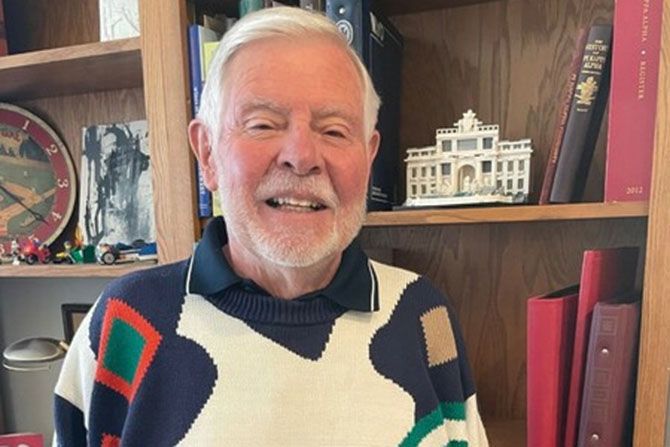Shortly after completing the Cheyenne Municipal Court Building in the late summer of 2020, Noel Griffith, Jr. retired. His career spanned over 50 years.
Noel’s touch can be seen in building designs across Cheyenne. His architectural philosophy always revolved around more than serving the basic needs of his clients. He listened and was attentive to their wants, and his collaborative approach took projects through every stage, from the initial design to the final ribbon-cutting.
AIA Wyoming recently interviewed Noel about his career and life and enjoyed getting to know him. The following is a recap of our conversation.
Where are you from originally?
I’m from Omaha, Nebraska.
Please tell us about your family (past and present).
My parents gave me a wonderful childhood. They taught me how to work and were very instrumental in getting me to be who I am today. I have one brother who is also retired; he lives in Idaho Falls, Idaho, and is a tremendous person.
My first wife and I were married for 53 years before she died of long-term cancer. We have three children, Troy Griffth, Nicole Griffith Hefele and Shad Griffith. We have five grandchildren. My current wife, Fran, and I enjoy traveling and keeping busy in our community.
When and why did you decide to become an architect?
During my ninth-grade year in high school, an architect spoke to our drafting class. I saw him as a good example of an architect helping his community and the profession. He was a wonderful gentleman, and I decided I wanted to be an architect.
A general building contractor named Keith Tobias hired me to do design and drafting work while I was still in high school. He was my first boss and mentor. I worked there while I was a student and continued working there after college graduation. We did large-scale residential and a little bit of small-scale commercial. I worked for him for eight years, and boy, did I learn. He taught me how to work with clients, work harder as a designer and architect, and run a business. He gave me a great deal of business knowledge. Once I was in college, my experiences with subcontractors greatly assisted me in learning the various aspects of architecture.
It is important to love your work. I still can’t think of a better profession than architecture, and I loved every minute of my work.
Please tell us about your education.
I graduated from Omaha Benson High School in 1960, attended the University of Omaha for two and a half years, transferred to the University of Nebraska in Lincoln in 1963, and graduated from the College of Architecture
in 1967.
How long have you been a member of AIA Wyoming? How did your membership benefit your career?
When I moved to Wyoming in 1974, I attended AIA meetings with my partners. I was a member on and off throughout my career until I retired in 2020.
AIA Wyoming’s standards and goals required me to practice as a professional. The association gave me goals and direction and increased my desire to help my community. I loved everything I’ve done for and with the community, and I intend to continue contributing now that I am retired.
As humans, we all need to get involved in our community. I learned that from my parents, bosses and associates, and I taught it to my children. All my children are involved in community service.
Architects can be leaders within their communities, but whether someone is an architect or not, they need to get out and help do wonderful things.
Please tell us about your first company, Noel Griffith Jr. & Associates.
I started the first company to have that name in Omaha, Nebraska, in 1968. Then I moved the company to Cheyenne and was in a partnership for two years as part of John Freed and Associates. I started my own office in 1975. From then until 2018, the company’s name was usually Noel Griffith Jr. and Associates.
Please tell us about Winters Griffith Architects.
I looked for 15 years to find the right person to hand off my company to before I retired. During that time, I turned down two to three offers from people to buy me out. Those opportunities were just not right.
When I found Jamie Winters in 2018, I knew he would be the correct person to take over the firm. The idea was that he would be a partner in less than six months and buy me out in less than two years.
Jamie is a young architect, but he has done his time and is very accomplished. I hired him as my chief associate, and I suggested we change the business name to Winters Griffith with his name first so clients would know that this was his company. He is currently keeping the name.
I was very fortunate to have a tremendous associate to turn the office over to, and Jamie is doing a great job. We are in a field where you can work forever, and I think Jamie will increase his business considerably in years to come.
What is your favorite project? If you can’t pick just one, please tell us about two or three of the best ones.
The firm did commercial and residential work, and there was a lot of work over 50 or 60 years. Starting when I was 17 years old, I always loved doing residential, and several of my large personalized homes are favorites. On the commercial side, my first bank building was the Equality State Bank, and my last project was the Cheyenne Municipal Court Building. I also enjoyed the Laramie County Government Complex.
What is your most important legacy as an architect?
I’m a Wrightian. I understand that form follows function, and my clients’ needs come first. I wasn’t building a monument to Noel Griffith; I was meeting my clients’ needs. That doesn’t mean I don’t remember I am an architect, but their needs were the most important thing. Remembering that was my most important architectural accomplishment.
For all my clients, residential and commercial, I had them write a letter to tell me what they wanted and what their desires were. I did that for 50 years. Then I would put the information into a program and develop their building.
At all times, I considered my clients’ needs above anything else. Their needs were paramount in my life as an architect.
I always considered clients to be personal friends by the end of a project, and I made many friends along the way.
Please tell us about your experiences as a college lecturer.
I was a part-time college lecturer at the University of Omaha for three years and then at the University of Wyoming for another three years. In both places, lecturing about professional practice allowed me to talk to students about the field and what architects do. I’ve also hired several good architects early in their careers. I’ve always loved education and working with young colleagues; they were wonderful. I learned as much from them as they learned from me. I always learned something when I taught a class. The students are young and energetic, and they push you. We did well together.
I had a design class for juniors at one point. When I told them how they ought to work, they asked, “Do you do that?” It was a good question. My answer was, “Yes, and I will continue to strive to do my work even better.”
My University of Wyoming students were juniors and seniors with grade point averages that started at 3.5 and went up. In my last class about professional practice for seniors, I told them that when they got out, they should own their firm or be a principal. I told them they all had the ability. They just needed to get it in gear and make it happen. Sometimes students from those classes call me to say, “Here is what I am doing, and this is the company I am running.”
If you were mentoring a young architect, what advice would you give them?
My advice has been that architects must have the ability to listen. If you listen, you learn and will do a better job. Also, you have to get yourself 100% into every project, no matter how big or small it is. Your work deserves 100% of your ability.
How has architecture changed during the decades you’ve been part of the profession?
Technology has changed. Auto CAD has taken us from being artists on the drawing board to clicking a keyboard and producing work on the computer. However, you still need a brain to use the new tools effectively.
I also think clients seem to be more educated. Their requirements are certainly demanding, which has also changed the field.
We are no longer the gods of the building industry. The engineers, the architects, the clients, the government, zoning and other requirements all contribute to the final project. It has been good. Architects have the key role, but we have become partners with other team members and are not ever doing the entire project by ourselves. And I think we know that now.
What are you doing now?
Fran and I live in Sun City West, Arizona, in the winter and in Prescott, Arizona, in the summer. I am helping the HOA by working on the architectural review board in Sun City West. We’ve only been in Prescott for six months, but I will help that community next year. Getting involved in the community and the HOA is a chance to stay a little involved.
We travel and keep in shape by playing bocce ball, pickleball and golf. It’s a good life.
Would you like to say something at the end of this article as a final comment about your architectural work?
I’m grateful for the opportunity to be interviewed and very honored to practice architecture for 50-60 years. Wyoming was a great place to practice, and I still consider Cheyenne to be my home.
Have dignity and honor, and be proud of all you do; confidence will take you far into the future that waits for you.








